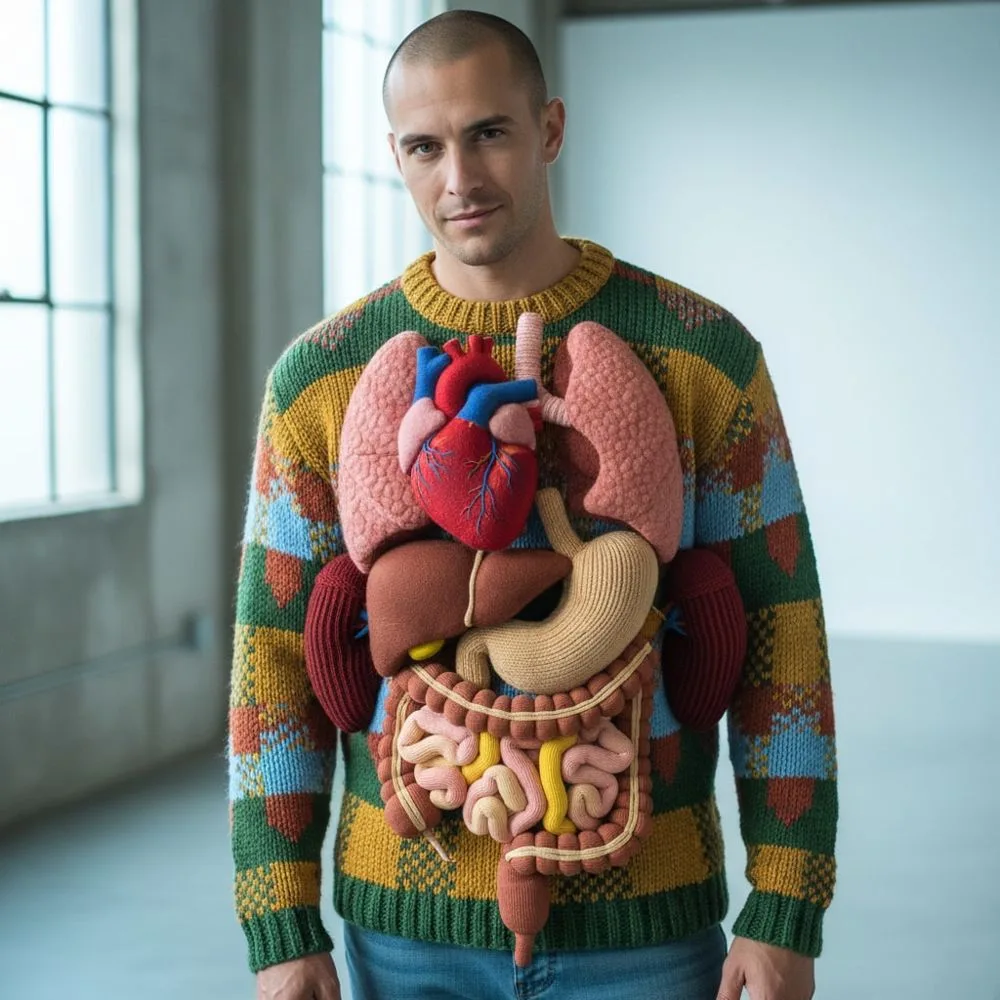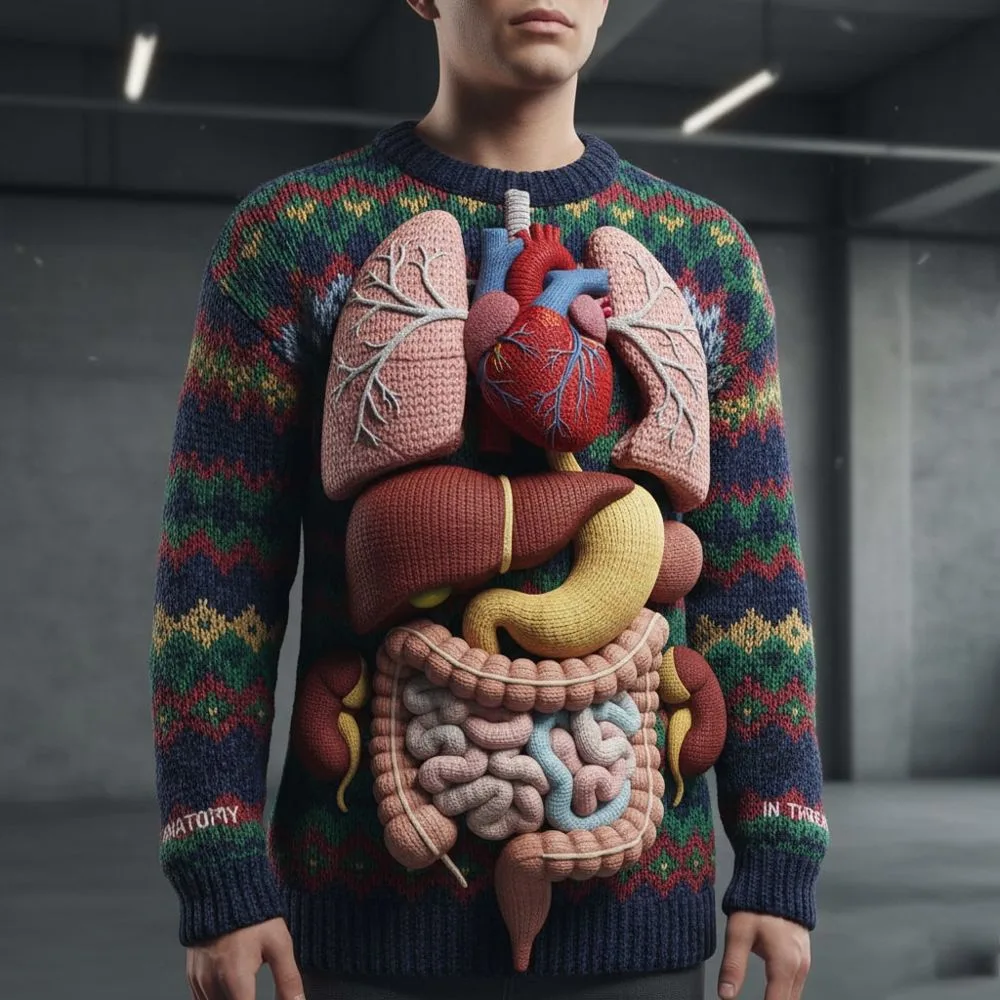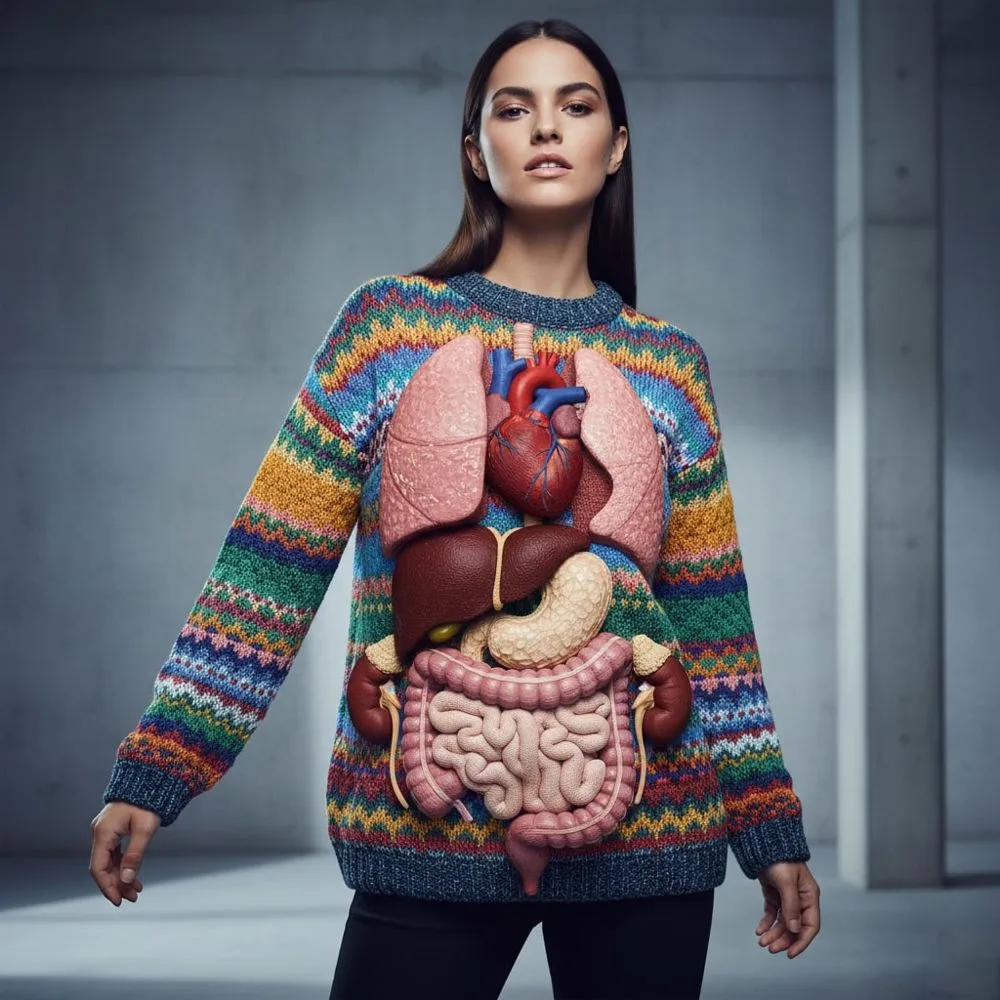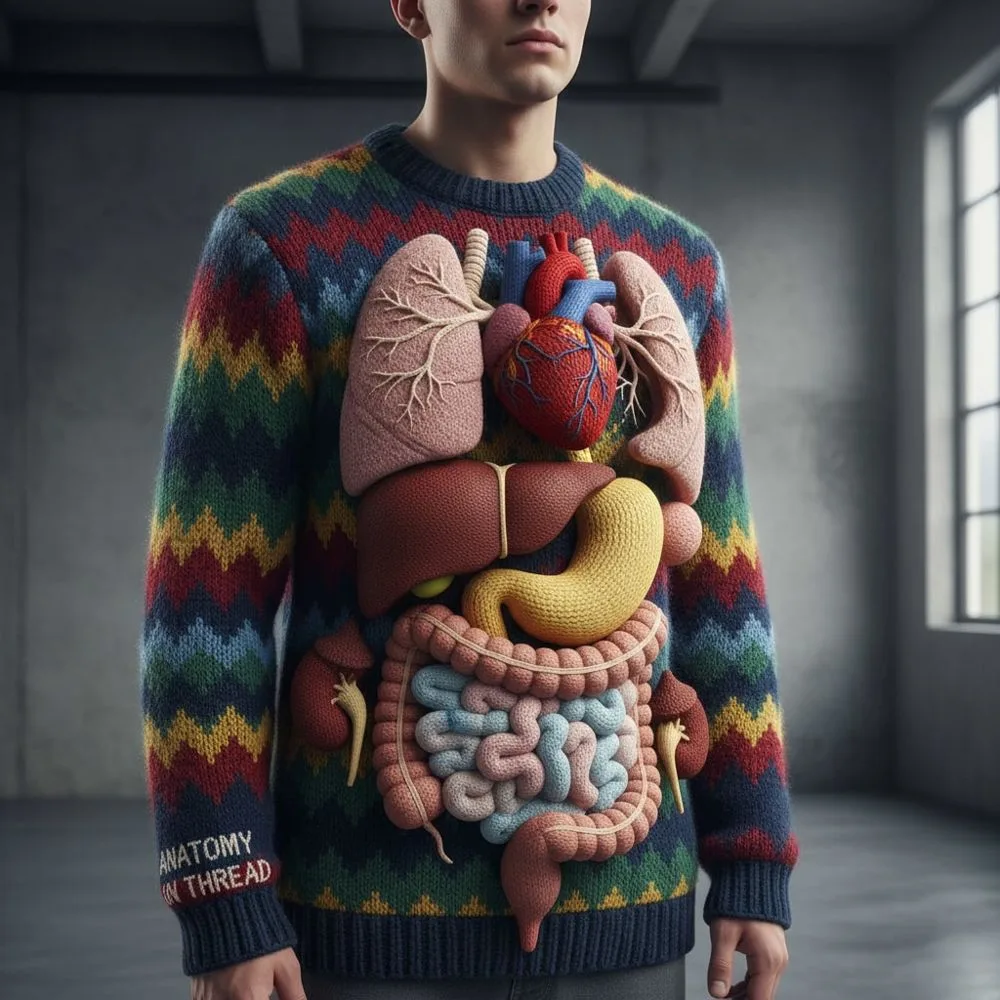The intersection of science and fashion has never been more captivating than with the rise of anatomy knitted sweaters. These remarkable garments transform the human body’s intricate systems into wearable art, creating conversation pieces that educate while they stylize. Whether you’re a medical student, science educator, or simply someone who appreciates unique fashion statements, anatomy knitted sweaters offer an extraordinary way to showcase your passion for the human form.
What Makes Anatomy Knitted Sweaters Special

The anatomy knitted sweater represents a fascinating fusion of scientific accuracy and artistic expression. Unlike traditional graphic tees or printed apparel, these sweaters use the medium of knitting itself to create three dimensional representations of human anatomy. The ribcage becomes actual ribbing, muscles are depicted through cable knit patterns, and skeletal structures emerge through carefully planned increases and decreases in the fabric.
These garments stand out in the fashion world because they serve dual purposes. They function as both educational tools and statement pieces, making complex anatomical concepts accessible through tactile, visual representation. The knitted format allows for incredible detail that printed designs simply cannot achieve, with different stitch patterns creating texture and depth that mirrors the actual structures they represent.
The craftsmanship involved in creating an authentic anatomy knitted sweater is extraordinary. Each piece requires extensive knowledge of both human anatomy and advanced knitting techniques. Designers must understand muscle fiber directions, bone structures, and organ placement while simultaneously mastering complex knitting patterns that can accurately represent these systems.
The Science Behind the Stitches

Understanding Anatomical Accuracy
Creating an anatomy knitted sweater requires meticulous attention to anatomical detail. The most successful designs work closely with medical professionals and anatomists to ensure accuracy in their representations. This scientific rigor sets apart quality anatomy knitted sweaters from novelty items that merely approximate human structures.
The skeletal system, often featured prominently in anatomy knitted sweaters, demands precise proportional relationships between different bones. The ribcage must show the correct curvature and spacing, while the spine requires accurate vertebral positioning. Advanced designs even incorporate the subtle differences between male and female skeletal structures.
Muscular system representations in anatomy knitted sweaters showcase the layered nature of human musculature. Surface muscles like the pectorals and deltoids are rendered in prominent relief patterns, while deeper muscle layers are suggested through subtler stitch variations. This layered approach helps viewers understand the complex three dimensional relationships within the human body.
Material Science and Comfort
The choice of yarn and materials in anatomy knitted sweaters affects both the educational value and wearability of the garment. Natural fibers like wool and cotton provide the structure needed for detailed anatomical features while maintaining comfort against the skin. Some designers incorporate metallic threads to highlight specific structures like the nervous system or circulatory pathways.
The weight and drape of the yarn directly impact how anatomical features appear on the finished sweater. Heavier yarns create more pronounced relief patterns, making skeletal and muscular features more prominent. Lighter weight yarns allow for finer detail but may require additional structural support to maintain the integrity of anatomical shapes.
Color selection plays a crucial role in anatomy knitted sweaters, with many designers using traditional anatomical color coding. Bones are typically rendered in cream or off white, muscles in various shades of red and pink, and organs in their characteristic colors. This color coding enhances the educational value while creating visually striking garments.
Design Variations and Styles

Full Body Anatomy Sweaters
The most comprehensive anatomy knitted sweaters feature complete anatomical systems across the entire garment. These designs typically focus on the torso, incorporating the ribcage, major muscle groups, and internal organs in a cohesive representation. The sleeves might feature arm bones and musculature, while the back of the sweater could display the spine and posterior muscle groups.
Full body designs require careful planning to ensure that anatomical features align properly when the sweater is worn. The three dimensional nature of the human form means that flat knitting patterns must account for how the fabric will drape and stretch over the body. Master designers use sophisticated mathematical calculations to ensure that a ribcage knitted flat will appear correctly proportioned when worn.
These comprehensive designs often incorporate multiple knitting techniques within a single garment. Fair Isle patterns might represent organ systems, cable knits could depict muscle fibers, and lace patterns might suggest the delicate nature of nervous system pathways. The result is a technically complex garment that showcases the full range of knitting artistry.
Specialized System Focus
Many anatomy knitted sweaters focus on specific anatomical systems rather than attempting to represent the entire body. Skeletal system sweaters are particularly popular, featuring detailed representations of the ribcage, spine, and arm bones. These designs often use white or cream colored yarn against darker backgrounds to create striking contrast.
Muscular system focused anatomy knitted sweaters emphasize the layered nature of human musculature through complex cable patterns and textural elements. These designs help viewers understand how muscles overlap and interact, making them valuable educational tools for fitness professionals and medical students.
Circulatory system anatomy knitted sweaters trace the pathways of major blood vessels through colorwork patterns. These designs often incorporate red yarn for arteries and blue for veins, following the traditional anatomical color scheme. The intricate branching patterns of blood vessels translate beautifully into knitted motifs.
Contemporary and Artistic Interpretations
Modern designers are pushing the boundaries of anatomy knitted sweaters by incorporating contemporary fashion elements while maintaining scientific accuracy. Oversized silhouettes, cropped designs, and avant garde construction techniques are being applied to anatomical themes, creating garments that appeal to fashion forward consumers.
Some designers are exploring abstract interpretations of anatomical structures, using the essential forms and relationships rather than literal representations. These artistic anatomy knitted sweaters maintain the educational core while offering more versatile styling options for everyday wear.
Hybrid designs that combine anatomical elements with other scientific themes are also emerging. Anatomy knitted sweaters might incorporate molecular structures, astronomical elements, or botanical patterns, creating interdisciplinary pieces that appeal to science enthusiasts across multiple fields.
Cultural Impact and Educational Value

Medical Education and Professional Development
Anatomy knitted sweaters have found unexpected applications in medical education settings. The tactile nature of knitted fabric allows students to feel anatomical structures in ways that traditional diagrams cannot provide. Many medical schools and anatomy programs now incorporate these garments into their teaching methodologies.
Healthcare professionals appreciate anatomy knitted sweaters as conversation starters with patients. A pediatric nurse wearing a skeleton sweater can help young patients understand their bodies in a non threatening way. Physical therapists use muscle focused designs to explain treatment approaches to their clients.
The three dimensional aspect of anatomy knitted sweaters helps bridge the gap between flat anatomical illustrations and actual human structures. Students can see how the ribcage curves around the body, how muscle layers interact, and how different systems relate spatially to one another.
Science Communication and Public Engagement
Beyond medical settings, anatomy knitted sweaters serve as powerful tools for science communication. Science museums, educational outreach programs, and public health initiatives use these garments to make anatomical concepts more accessible to general audiences.
The approachable nature of knitwear helps reduce the intimidation factor often associated with medical and anatomical education. People who might shy away from formal anatomy lessons are drawn to explore these concepts when presented through the familiar medium of sweaters.
Social media has amplified the impact of anatomy knitted sweaters, with images of these unique garments regularly going viral. This online visibility helps spread anatomical literacy and generates interest in both science education and fiber arts.
Styling Your Anatomy Knitted Sweater

Professional and Academic Settings
Wearing an anatomy knitted sweater in professional medical or educational environments requires thoughtful styling. Pairing a skeletal system sweater with tailored trousers and blazer creates a look that is both scientifically informed and professionally appropriate. The key is balancing the statement nature of the garment with conventional professional elements.
In academic settings, anatomy knitted sweaters can be styled more casually while still maintaining appropriate boundaries. Layering over collared shirts or pairing with academic staples like tweed skirts creates looks that honor both fashion and scholarly tradition.
The educational value of anatomy knitted sweaters makes them particularly appropriate for teaching environments. Students and colleagues naturally gravitate toward these conversation starting garments, creating opportunities for informal learning and discussion.
Casual and Social Situations
Outside professional settings, anatomy knitted sweaters offer numerous styling possibilities. The key is treating them as statement pieces and building outfits that complement rather than compete with their distinctive designs. Neutral bottoms and minimal accessories allow the anatomical details to take center stage.
For social gatherings, anatomy knitted sweaters serve as excellent icebreakers. Their unique nature naturally draws attention and curiosity, making them perfect choices for events where networking or meeting new people is desired. The scientific theme provides ready conversation topics for diverse audiences.
Seasonal styling considerations are important with anatomy knitted sweaters. The substantial nature of most designs makes them ideal for cooler weather, but lighter weight versions can work in transitional seasons when paired appropriately.
Care and Maintenance
Proper care of anatomy knitted sweaters ensures their longevity and maintains the integrity of their anatomical features. The complex construction of these garments requires special attention during washing and storage. Hand washing is typically recommended to prevent distortion of detailed anatomical elements.
The dimensional aspects of anatomy knitted sweaters make them susceptible to stretching and pulling. Proper storage on shaped hangers or flat storage prevents sagging and maintains the correct proportions of anatomical features. Regular inspection for loose stitches or pulled threads helps prevent damage to intricate details.
Professional cleaning may be necessary for anatomy knitted sweaters with complex colorwork or specialty fibers. The investment in proper care preserves both the educational value and aesthetic appeal of these unique garments.
The Future of Anatomy Knitted Sweaters

Technology Integration
Emerging technologies are opening new possibilities for anatomy knitted sweaters. Smart fibers that can change color or provide haptic feedback could create interactive educational experiences. Imagine a circulatory system sweater that lights up to show blood flow patterns or a nervous system design that responds to touch.
3D knitting technologies are enabling more accurate anatomical representations with seamless construction. These advanced manufacturing techniques allow for precise shaping and dimensionality that traditional flat knitting cannot achieve. The result is anatomy knitted sweaters with unprecedented anatomical accuracy.
Augmented reality applications could overlay additional information onto anatomy knitted sweaters, creating immersive educational experiences. Students could point their devices at specific anatomical features and receive detailed explanations, animations, or related information.
Sustainable and Ethical Production
The future of anatomy knitted sweaters increasingly focuses on sustainable and ethical production methods. Designers are exploring eco friendly yarn options, including recycled fibers and sustainably sourced natural materials. This shift aligns with growing consumer awareness of environmental impacts in fashion.
Local production and artisan collaboration are becoming more important in anatomy knitted sweater creation. Supporting skilled craftspeople while reducing transportation impacts appeals to consumers who value both quality and sustainability. Many designers now work directly with knitting communities to create their anatomically accurate pieces.
The educational mission of anatomy knitted sweaters aligns naturally with ethical fashion principles. These garments are designed for longevity and purpose rather than disposability, making them inherently more sustainable than fast fashion alternatives.
Making the Investment: Quality and Value

Identifying Quality Construction
Investing in a high quality anatomy knitted sweater requires understanding the markers of superior construction and design. The accuracy of anatomical representations should be the primary consideration, with designs that show proper proportional relationships and scientifically correct details commanding higher value.
Stitch quality and consistency throughout the garment indicate skilled craftsmanship. Complex anatomical features should be rendered with clean, even stitches that maintain their shape over time. Poor quality construction becomes apparent in distorted anatomical features or loose, uneven knitting.
Material quality directly impacts both the appearance and longevity of anatomy knitted sweaters. Premium natural fibers or high performance synthetic blends provide better durability and comfort than cheaper alternatives. The investment in quality materials pays off in garments that maintain their educational and aesthetic value over many years.
Understanding Price Points
The pricing of anatomy knitted sweaters reflects the specialized knowledge and skilled craftsmanship required for their creation. Custom designed pieces command premium prices due to the extensive development work required to ensure anatomical accuracy while maintaining knitting feasibility.
Production method significantly impacts pricing, with hand knitted anatomy sweaters typically costing more than machine produced versions. However, hand knitting often allows for greater detail and customization, making the premium worthwhile for serious collectors or professional applications.
Limited edition or artist collaborations in anatomy knitted sweaters often represent the best value for serious enthusiasts. These pieces combine scientific accuracy with artistic vision, creating garments that appreciate in value while serving their educational mission.
Conclusion
The anatomy knitted sweater represents a remarkable convergence of scientific education, artistic expression, and functional fashion. These extraordinary garments transform complex anatomical concepts into tangible, wearable forms that educate and inspire. From medical students seeking engaging study aids to fashion enthusiasts drawn to unique statement pieces, anatomy knitted sweaters offer something genuinely special in a world of mass produced clothing.
The future of anatomy knitted sweaters looks bright, with advancing technologies enabling even greater accuracy and interactivity while sustainable production methods align with evolving consumer values. As our understanding of both human anatomy and fiber arts continues to evolve, these remarkable garments will undoubtedly continue pushing boundaries and creating new possibilities for science communication through fashion.
Whether you choose an anatomy knitted sweater for its educational value, artistic merit, or simply its ability to start conversations, you are investing in a piece that celebrates the remarkable complexity and beauty of the human form. In a world where science and art too often seem separate, these garments remind us that the greatest achievements come from bringing different disciplines together in service of human understanding and expression.

